柴油机颗粒捕集器再生温度预测模型
2019-12-19石秀勇蒋得刚
石秀勇,蒋得刚
柴油机颗粒捕集器再生温度预测模型
石秀勇,蒋得刚
(同济大学汽车学院,上海 201804)
柴油机颗粒捕集器在再生阶段的温度预测问题直接与后处理系统甚至整车的经济性、安全性相关。该文采用仿真分析计算与发动机试验验证相结合的方式,对柴油机颗粒捕集器在再生阶段的温度特性及其影响因素进行分析。首先运用GT-Power软件对后处理系统进行建模,并分析了不同再生目标温度对再生效率的影响以及不同碳载量对稳态再生温度的影响。仿真结果表明:较高的再生目标温度有助于降低单位质量颗粒物的再生油耗,当再生目标温度为500 ℃时,单位质量颗粒物的再生油耗为372.7 g,当目标温度提高到700 ℃时该值降低至3.8 g,但当目标温度达到600 ℃以上,再生目标温度对单位质量颗粒物再生油耗的改善效果不明显;当碳载量超过46 g(12.7 g/L)再生时,颗粒捕集器内部温度超过800 ℃,颗粒捕集器出现烧蚀失效的风险较高,因此应当限制触发再生的碳载量限值。在仿真计算结果的基础上,运用发动机台架试验对再生温度特性进行测试验证,试验结果与仿真结果较吻合,结果表明,该温度预测模型可对颗粒捕集器再生阶段的温度分布、再生油耗及最高温度等进行预测,对提高再生阶段燃油经济性,降低颗粒捕集器的烧蚀失效风险,具有重要的指导意义。
柴油机;燃烧;载碳量;再生温度;台架试验;模拟仿真
0 引 言
柴油机颗粒捕集器(diesel particulate filter,DPF)的再生温度预测问题是目前困扰诸多企业的技术难点,在项目开发中,企业往往通过发动机台架及整车标定的方式对再生目标温度及最大碳载量等进行标定,对台架资源、人力资源等的依赖较高,易造成项目开发成本高、开发周期长等问题。
DPF 在再生阶段的温度表现主要依赖于氧化型催化器(diesel oxidation catalyst,DOC)内部发生氧化反应的放热情况。国内外学者对DOC 及DPF 的再生温度控制及温度预测等技术进行了较为深入的研究。Bensaid等[1]对DPF 碳加载过程及再生过程的压差及温度表现、污染物排放情况进行了试验研究;Chaillou等[2]对再生过程温度表现及其控制技术进行了试验研究;Yoon等[3]对驻车再生时的油耗及温度表现进行了试验研究;Gurupatham等[4]运用Matlab/Simulink 建立了后处理仿真模型,对再生温度表现及对污染物的过滤情况进行了仿真研究;周一闻等[5]通过GT-Power 软件建立了DPF 的热再生模型;Bai等[6]对重型发动机DPF系统碳载量估算及被动再生特性进行了建模分析;Flörchinger等[7-8]对固体颗粒物排放控制技术进行了探索和总结;Chong等[9-10]对再生温度控制技术进行了理论分析和试验验证;Ishizawa等[11]对灰分累积量及其对再生方式的影响进行了研究;Mamontova等[12-14]讨论了新型燃油对DPF的影响;Bai等[15-17]对DPF再生温度控制技术进行了研究;Hou等[18]对灰分的形成机理及其对DPF再生的影响进行了分析;di Iorio等[19]对固体颗粒物的质量、尺寸等进行了试验研究;Gurupatham等[20]对DOC+DPF系统结构设计进行了研究;Hou等[21]运用GT-Power软件对DPF的再生过程进行了仿真分析;Ning等[22-24]对再生阶段的DOC温度控制技术进行了研究;Yamamoto等[25]对DPF 的被动再生过程进行了仿真分析;Khan等[26]对再生过程进行了仿真分析;Rumminger等[27]对再生阶段的温度动态响应进行了研究;Magdi等[28-30]对DPF及排放控制技术进行了总结概述。
以上研究工作获得了很多有价值的研究成果,但对于再生效率的量化比较以及仿真与试验相结合的再生温度控制却鲜有涉及。本文以一台2.5L发动机为研究对象,通过搭建再生温度预测模型对后处理系统在再生阶段的温度控制进行由理论分析到仿真计算再到试验验证的系统性研究。
1 再生温度控制仿真分析
DOC内部的化学反应直接影响着DPF再生温度控制功能的实现。如式(1)所示,本研究基于Roy Douglas等[30]提出的氧化型催化器化学反应速率经验公式,对DOC内部的化学反应进行建模分析。

式中R为化学反应速率,mol/(m3·s);k为指前因子,mol/(m3·s);T为化学反应的活化温度,K;T为载体局部壁面温度,K;X为组分的摩尔分数,%。
由式(1)可知,化学反应的速率与载体局部壁面温度呈正相关关系。载体的局部壁面温度主要受排气温度、DOC入口处气体的混合均匀性、封装结构的保温性能以及载体材质的比热容等因素的影响。针对化学反应速率与载体局部壁面温度的关系,本文对不同的再生目标温度进行仿真分析计算。
化学反应速率与参与化学反应组分的摩尔分数呈正相关关系。排气中组分的摩尔分数主要受发动机燃烧情况、燃油品质、EGR率及温度等因素的影响。针对化学反应速率与参与化学反应的组分的摩尔分数的关系,本文对不同碳载量下的再生情况进行仿真分析和试验研究。
为验证载体局部壁面温度及化学反应组分对DPF再生温度分布的影响,本文搭建了后处理DOC+DPF仿真模型,通过定义进入后处理系统的排气温度、原排情况等可对DPF的固体颗粒物捕集过程及再生温度分布进行仿真计算。如图1所示,该模型主要由以下几部分构成:
1)Soot_inlet及管路模块:用于模拟发动机在实际运行时排气管路中的固体颗粒物含量,此模块可根据发动机台架采集的数据,并结合运行工况查表得到排气中相应的固体颗粒物含量;
2)DOC及DOCMonitor模块:DOC模块用于对DOC内部化学反应进行仿真模拟,DOCMonitor模块用于对相关变量进行监测和实时显示;
3)cDPF及cDPFMonitor模块:cDPF模块用于对DPF内部的化学反应、颗粒物捕集过程及压降进行模拟,cDPFMonitor模块用于对相关过程进行监测和实时显示;
4)Temperature_Monitor模块:用于监测仿真过程的温度分布。

1.Soot inlet及管路模块2.DOC及DOCMonitor模块3.cDPF及cDPFMonitor模块4.Temperature Monitor模块
模型中的DOC及DPF参数如表1所示。
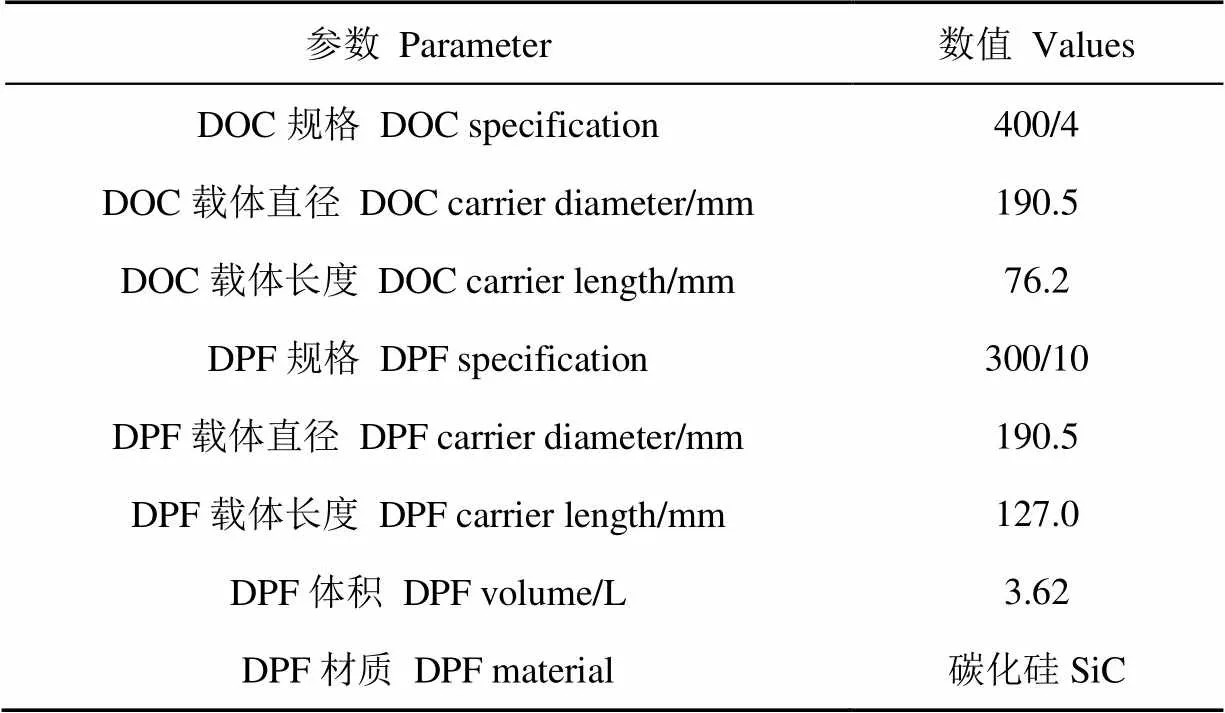
表1 DOC及DPF基本参数
1.1 不同再生目标温度对再生效率的影响
化学反应速率R与局部壁面温度T呈正相关关系,然而,若局部壁面温度过高,DPF内部固体颗粒物剧烈燃烧,易导致载体表面的涂层脱落,甚至DPF烧蚀。因此,再生目标温度的设定与DPF的再生效率及后处理系统的使用安全性等息息相关。
选取500、550、600、650 和700 ℃共5种不同再生目标温度,并给定相同的DOC入口排气温度(400 ℃)、排气流量(50 g/s)及初始碳载量(25 g),对不同再生目标温度下DOC及DPF的温度分布、再生速率以及再生燃油消耗情况进行对比。如图2,在DOC及DPF中心轴线沿排气方向均匀设置6个温度测点,以监测再生过程中DOC及DPF不同位置的温度变化情况,T1位于DOC或DPF前端面圆心位置,该位置与工程应用中实际使用的DOC或DPF前温度传感器的位置相近,T6位于后端面圆心位置,该位置与工程应用中实际使用的DOC或DPF后端温度传感器的位置相近,T2、T3、T4及T5分别位于轴线长度20%、40%、60%及80%位置。图3为不同再生目标温度下DOC各处温度仿真结果。图4为不同再生目标温度时DPF各处温度仿真结果。
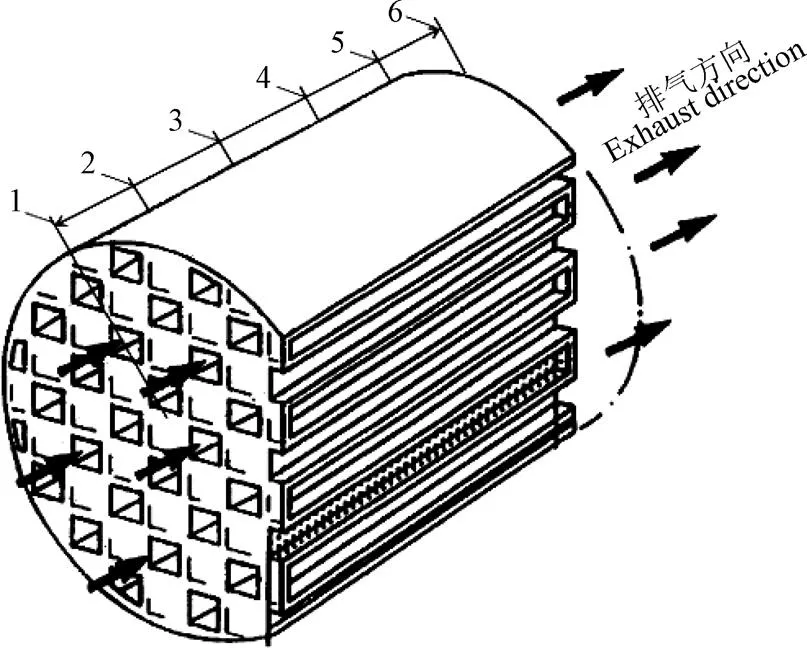
1.测点T1 2.测点T2 3.测点T3 4.测点T4 5.测点T5 6.测点T6
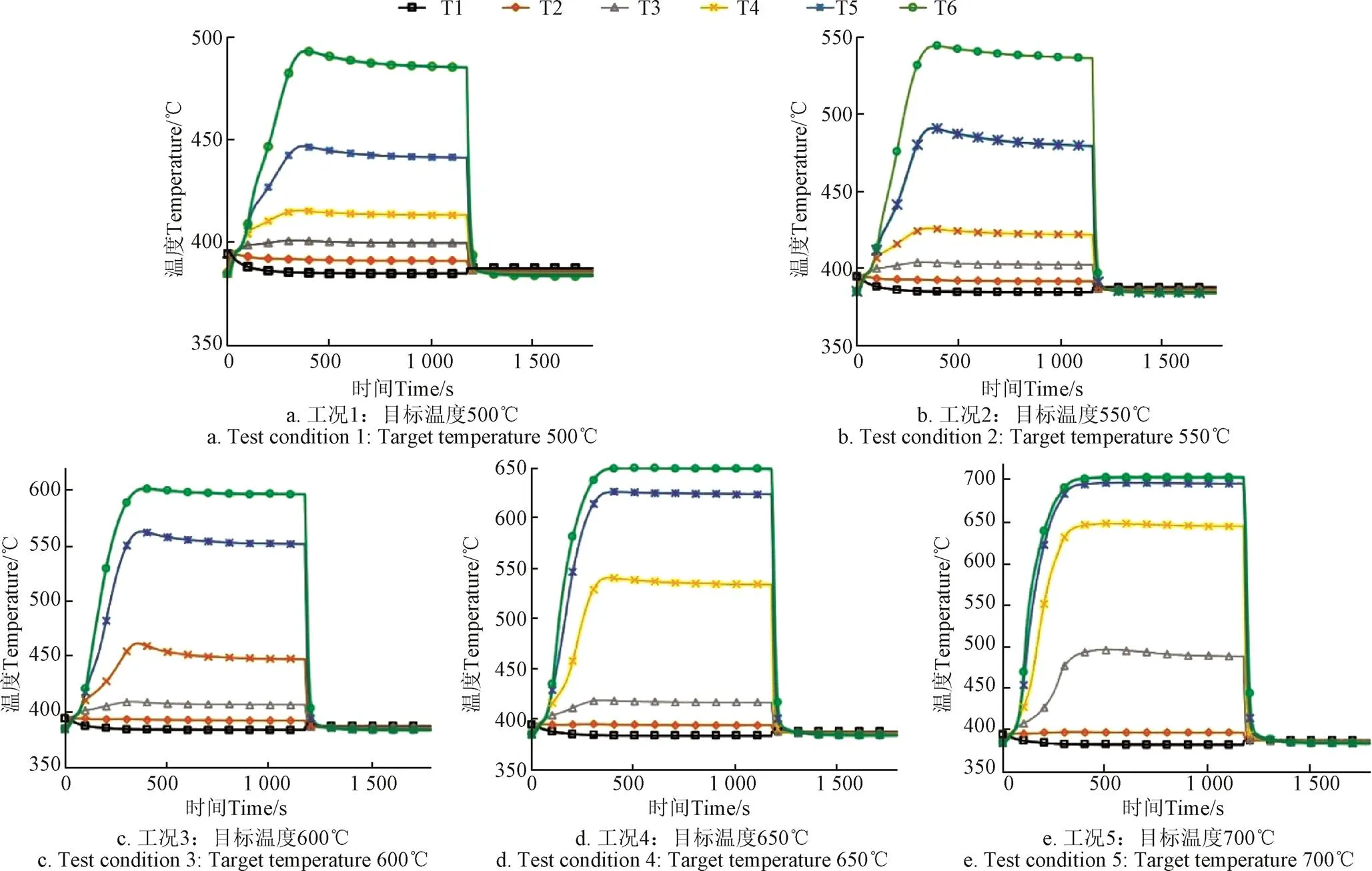
图3 再生阶段DOC温度分布
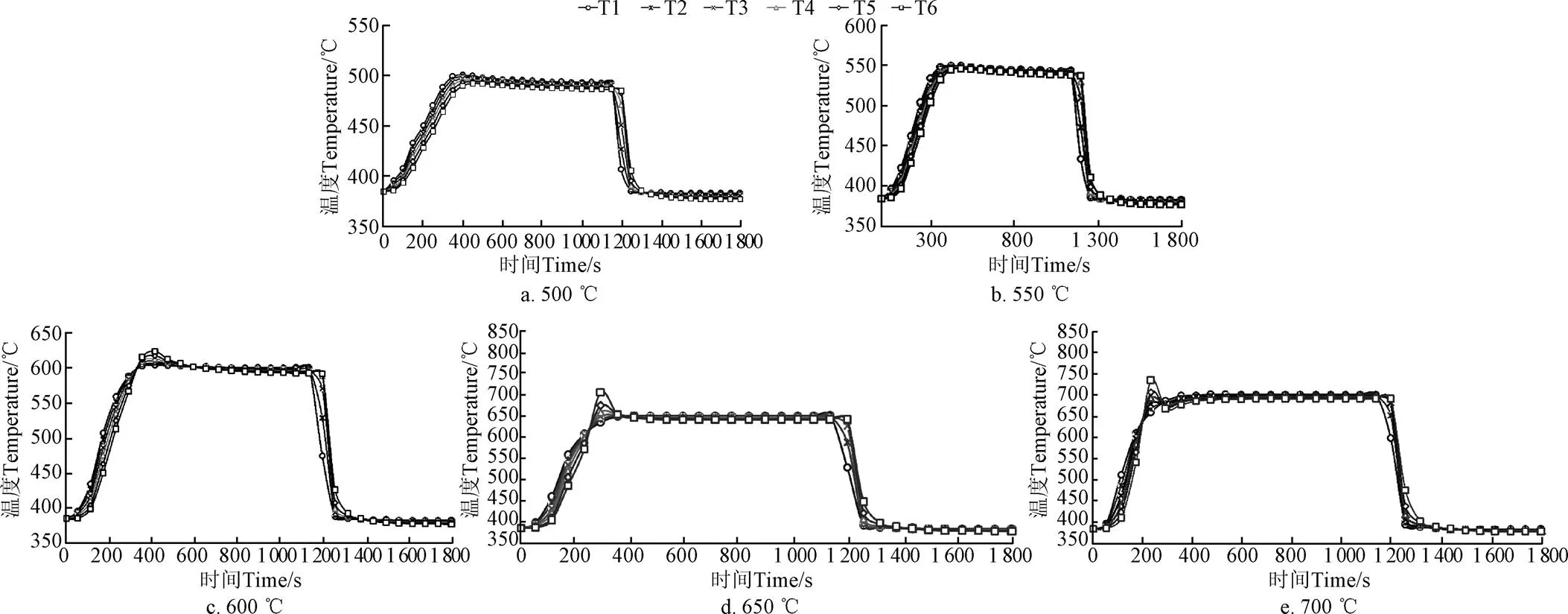
图4再生阶段DPF温度分布
由图3及图4可知:再生目标温度较高时,固体颗粒物燃烧剧烈,DPF内部各处的温度剧烈震荡,当目标温度为700 ℃时,DPF内部最高温度达到816.3 ℃,比目标温度高116.3 ℃。
图5为不同再生目标温度下固体颗粒物减少情况。图6为不同再生目标温度下累计燃油消耗量。当再生消耗掉的碳载量达到初始碳载量(25 g)90%时,大部分固体颗粒物被消除,可认定再生基本完成,剩余10%(2.5 g)可在再生结束后温度下降过程中基本消耗殆尽,故选取该时间点对比再生过程用时以及累计燃油消耗量,并对比DPF内部最高温度,结果如表2所示。
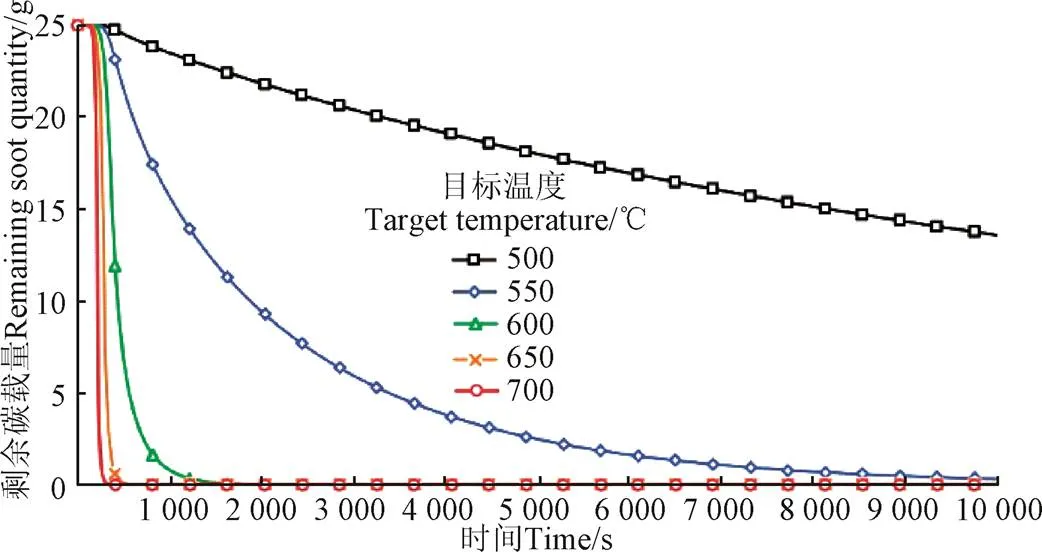
图5 再生阶段颗粒物变化情况

图6累计燃油消耗量
由图5、图6及表2结果可知:
1)以固体颗粒物的90%被再生所用时间为衡量标准,目标温度为500 ℃时用时29 700 s,目标温度为550 ℃时用时4 109.5 s,目标温度为600 ℃时用时744.5 s,目标温度为650 ℃时用时400 s,目标温度为700 ℃时用时270.5 s,即再生相同碳载量,目标温度越低用时越长;
2)再生启动后400 s时,目标温度为500 ℃时再生效率为0.5%,目标温度为550 ℃时再生效率为2.9%,目标温度为600℃时再生效率为24.1%,目标温度为650 ℃时再生效率为86.6%,目标温度为700 ℃时再生效率为99.9%,即在相同时间内目标温度越高,再生效率越高;
3)如图7所示,目标温度为500 ℃时单位质量颗粒物的再生油耗为372.7 g,目标温度为550 ℃时为55.9 g,目标温度为600 ℃时为10.3 g,目标温度为650 ℃时为5.7 g,而目标温度为700 ℃时为3.8 g,即目标温度越高,单位质量固体颗粒物的再生油耗越低,当目标温度达到600 ℃以上时,目标温度对再生油耗的改善效果不明显。

表2 不同目标温度下不同再生时间的再生结果分析
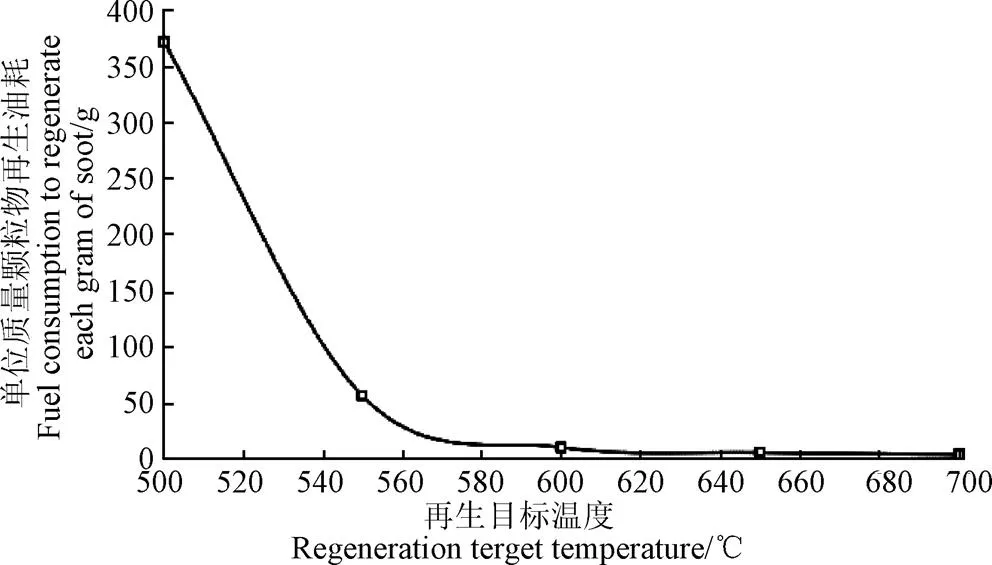
图7 单位质量颗粒物再生油耗
综上所述,更高的再生目标温度可提高再生效率,降低单位质量固体颗粒物的再生油耗。在实际应用中需综合考虑再生效率及再生安全性等因素,往往选择600 ℃作为再生目标温度,以避免DPF烧蚀等失效的出现,并同时兼顾再生油耗等影响因素。
1.2 不同碳载量对稳态再生温度的影响
若触发再生时DPF内部的碳载量过高,固体颗粒物发生剧烈燃烧,载体壁面温度急剧升高,容易导致DPF出现烧蚀失效,同时,过高的碳载量也导致发动机排气背压过高,影响车辆的动力性及经济性表现;若触发再生的碳载量限值过低,则易导致DPF频繁再生,对车辆的燃油经济性造成负面影响。因此,需综合考虑DPF再生过程安全性及车辆动力性、经济性等多方面因素合理设置触发再生的碳载量限值。
如图8所示,在DPF载体中心轴线沿排气方向不同位置设置温度测点,以分析DPF在再生过程中不同位置的温度变化情况,测点S1位于DPF前端面圆心位置,S2位于距离前端面20 mm处,S3位于31.8 mm处,S4位于63.5 mm处,S5位于95.3 mm处,S6位于距离后端面20 mm处,S7位于后端面圆心位置。如表3所示,选取发动机的典型运行工况,设定再生目标温度为600 ℃,对不同碳载量的再生温度分布进行仿真计算,并测试不同碳载量下再生时DPF内部最高温度。不同碳载量时的DPF再生温度数据见图9。
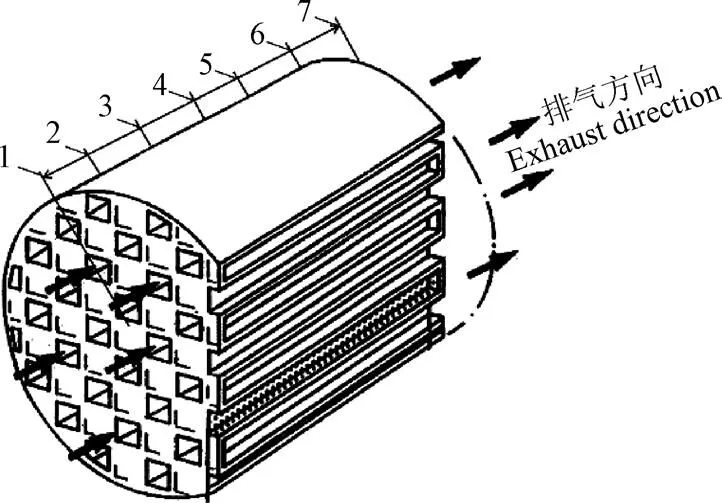
1.测点S1 2.测点S2 3.测点S3 4.测点S4 5.测点S5 6.测点S6 7.测点S7
根据表3及图9可知:
1)在升温阶段,DPF内部最高温度出现在靠近DPF入口的位置,随着再生进程的推进,DPF尾端的温度逐渐升高并超过DPF入口处的温度值。这是由于DPF内部的固体颗粒物主要集中在DPF尾端附近,随着固体颗粒物的燃烧,DPF尾端温度升高;
2)如图9d~9f所示,接近600 ℃时DPF内部温度急剧升高,持续时间约为200 s左右,整个再生过程的最高温度也出现在该阶段;
3)碳载量为10 g时DPF内部最高温度为603.1 ℃,碳载量为15.5 g时最高温度为607.6℃,碳载量为21.9 g时最高温度为619 ℃,碳载量为36.5 g时最高温度为677 ℃,碳载量为46 g时最高温度为801 ℃,碳载量为56 g时最高温度为908.7 ℃,即当碳载量超过46 g再生时,DPF内部最高温度超过800 ℃,DPF出现烧蚀失效的风险较高。

表3 不同测试工况和初始碳载量下DPF内最高再生温度
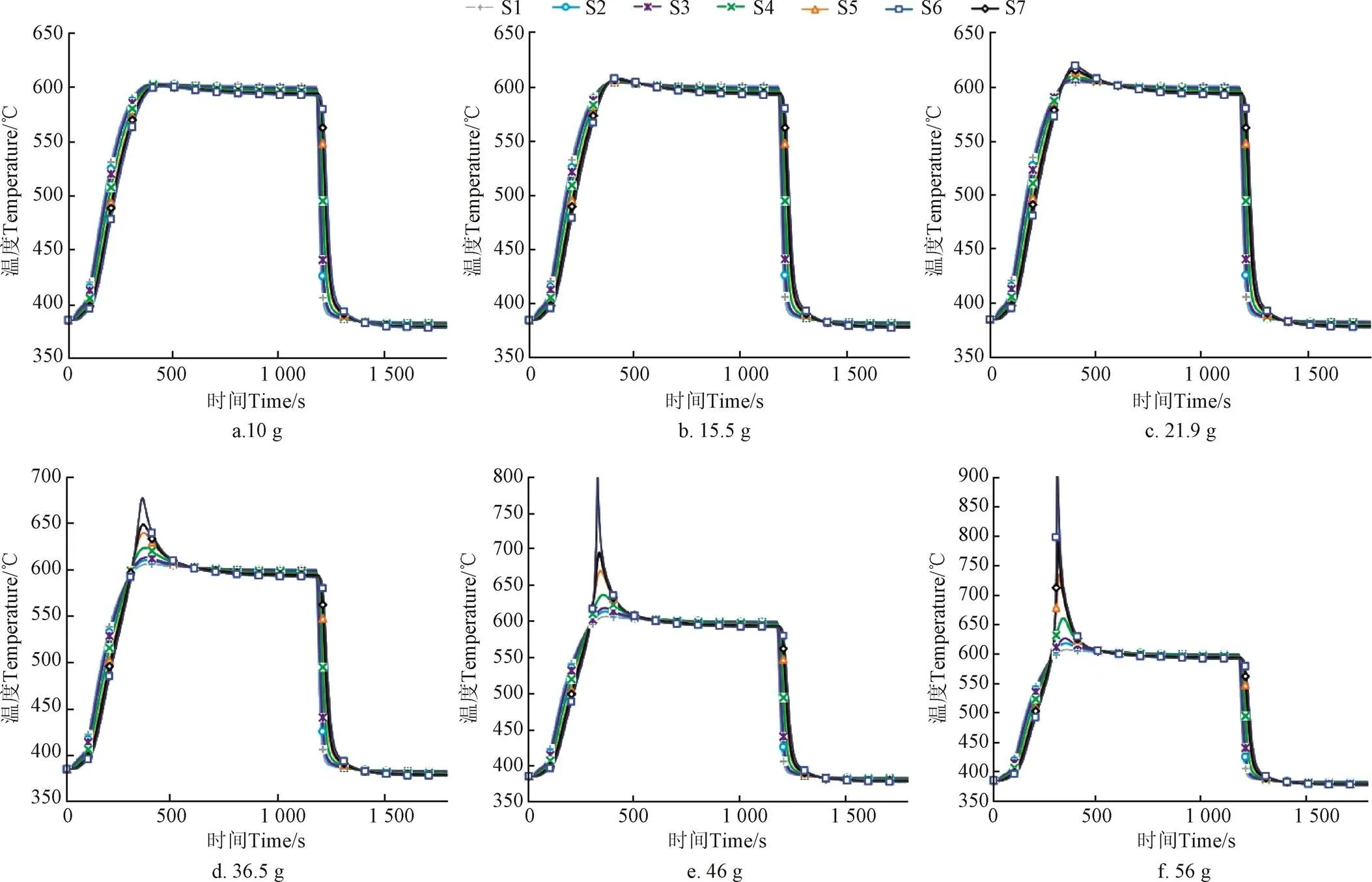
图9 不同碳载量下的DPF再生温度轴向分布
根据仿真结果,对于本文所研究的体积为3.62 L的DPF,碳载量超过46 g时DPF烧蚀失效的风险较高,因此应当控制触发DPF再生的碳载量限值在46 g以下,以确保再生过程的安全、可控进行。
2 台架验证试验
2.1 试验系统搭建
如图10所示,本研究采用D25TCIF型发动机作为废气源。试验所使用的发动机及后处理系统的主要参数如表4所示,该发动机是直列四缸增压中冷高压共轨电控柴油发动机,排量为2.499 L,额定功率为110 kW,最大扭矩为400 N·m,DOC载体规格为400/4,DPF载体规格为300/10,DOC及DPF材质均为堇青石。试验中采用的仪器设备包括CW440水力测功机、TMB-K-0.5-600热电偶温度传感器、PT200排气温度传感器、IND560电子天平、ES620及ES650温度采集模块等。

1.排气方向 2.DOC前温度传感器 3.DOC 4.DPF前温度传感器 5.DPF 6.压差传感器 7.热电偶温度传感器
2.2 不同碳载量下稳态再生试验研究
本试验通过在DPF内部不同位置设置热电偶温度传感器的方式,测试DPF在再生工况下不同位置的温度分布。在距离DPF入口端面20 mm的平面1圆心位置设置温度测量点1,在DPF的中心位置(平面2)圆心位置设置温度测量点6,在距离DPF出口端面20 mm的平面3圆心位置设置温度测量点7(图11)。
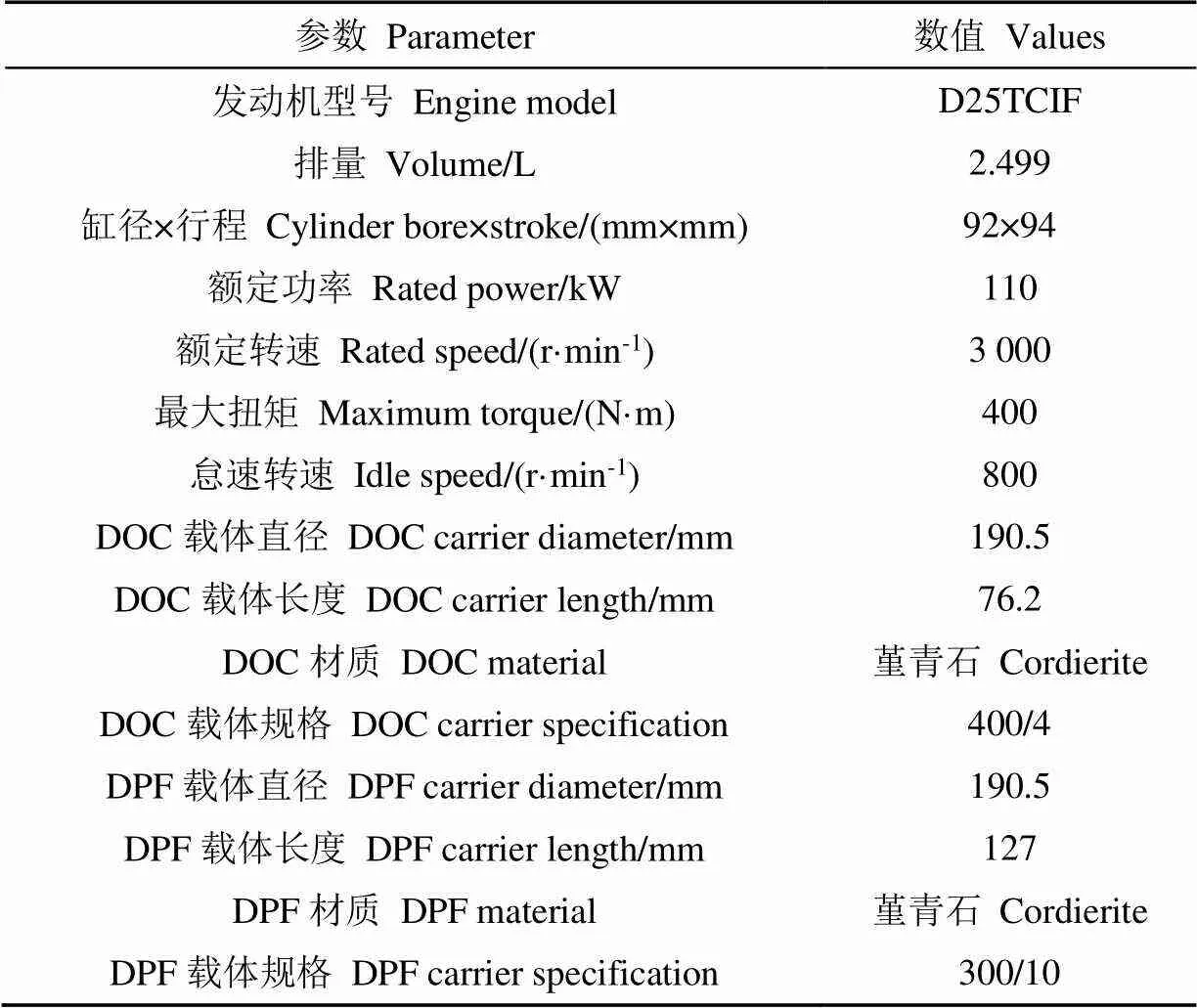
表4 试验用发动机及后处理系统参数
选取3组含固体颗粒物的DPF为对象,初始碳载量分别为15.5 g(4.28 g/L)、21.9 g(6.04 g/L)和36.5 g(10.09 g/L),选取测点1试验结果与本文1.2节测点S2仿真值进行对比;测点2试验结果与S4仿真值对比;测点3试验结果与S6仿真值对比。根据仿真结果,碳载量超过36.5 g再生时,存在较大的DPF高温烧蚀风险,故本文未针对更高的碳载量进行试验研究。
图12和表5为碳载量分别为15.5、21.9及36.5 g的DPF轴向再生温度及与仿真结果对比。
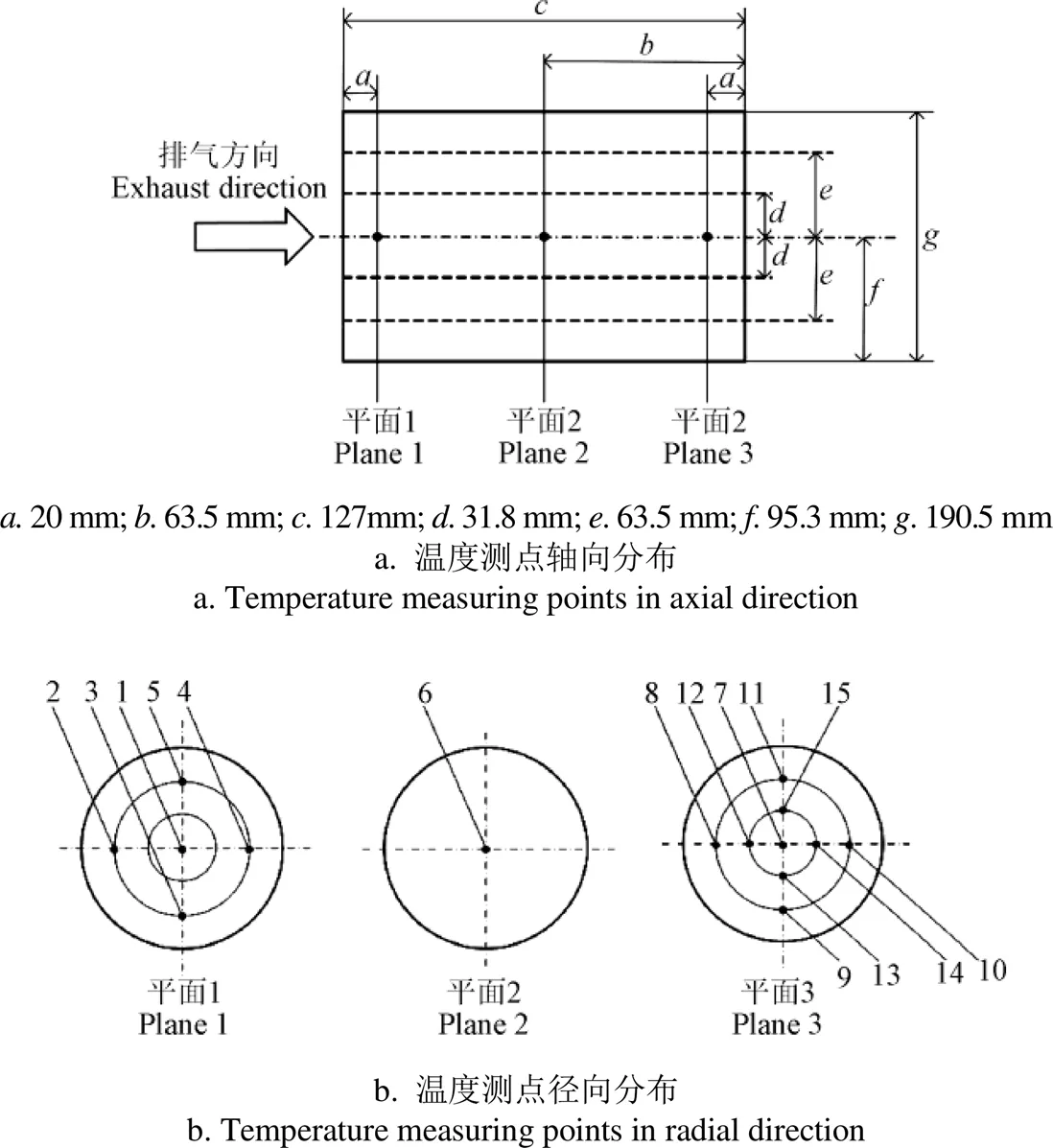
注:1~15为温度测点。

图12 不同载碳量的DPF轴向再生温度及其与仿真结果对比
试验结果表明,当碳载量为15.5 g时试验结果与仿真结果的偏差为−6.0~3.8 ℃之间,相对误差在−1.0%~0.4%之间,碳载量为21.9 g时两者的偏差为−8.5~5.0 ℃之间,相对误差在−1.4%~0.8%之间;当碳载量为36.5 g时,出现最高温度的时间点以及在最高温度附近的温度波动情况,试验结果与仿真结果存在较大误差,最高温度值的绝对误差为−22.1~7.2 ℃之间,相对误差为−3.7%~1.1%之间,值得注意的是,表5中仿真结果的最高温度为仅考虑DPF轴向S2、S4及S6三个测点的温度值,结合表3对DPF轴向各位置的仿真结果可知,DPF内部温度场情况与测点位置息息相关。试验结果表明,预测模型可有效预测再生阶段温度,对降低颗粒捕集器烧蚀风险具有重要的指导作用。

表5 不同载碳量的DPF轴向再生温度及其与仿真结果对比
3 结 论
本文进行了DPF再生温度预测技术的研究,搭建了仿真模型,并进行了仿真计算和发动机台架试验验证。结果表明,模型可对再生阶段的温度分布、再生油耗及最高温度等进行预测,对提高燃油经济性,降低颗粒捕集器的烧蚀失效风险,具有重要的指导意义。
1)建立了DPF再生温度预测模型,仿真及台架试验结果表明,模型可有效预估DPF在再生阶段的温度分布情况;
2)再生目标温度越高,再生用时越短,油耗越低,当目标温度超过600℃时,单位质量颗粒物再生油耗下降至10.3 g以下,目标温度对单位质量颗粒物再生油耗的改善作用效果不明显;
3)当碳载量超过46g再生时,DPF内部最高温度超过800 ℃,DPF出现烧蚀的风险较高;
4)当碳载量为15.5时,试验结果与仿真计算结果的相对误差在-1.0%~0.4%之间;碳载量为21.9 g时相对误差为-1.4%~0.8%之间;碳载量为36.5g时相对误差为-3.7%~1.1%之间;试验结果表明,碳载量过高时进行再生将导致DPF烧蚀风险增加;
未来的研究可综合考虑后处理系统与环境的热散失、催化剂的老化、发动机的燃烧对排气组分的影响等多方面因素,搭建较完善的后处理系统被控对象模型,以期在满足愈发严苛的排放法规的同时,减少后处理系统开发的工作量。
[1] Bensaid S, Caroca C J, Russo N, et al. Detailed investigation of non-catalytic DPF regeneration[J]. Canadian Journal of Chemical Engineering,2011, 89(2): 401-407.
[2] Chaillou Christophe, BouetAlexandre, Frobert Arnaud, et al. After-treatment investigation on particulates characterization and DPF regeneration of a naphtha fuel in a compression ignition engine[J]. SAE International Journal of Fuels and Lubricants,2016, 9(3): 633-649.
[3] Yoon Seungju, Quiros David C, Dwyer Harry A, et al. Characteristics of particle number and mass emissions during heavy-duty diesel truck parked active DPF regeneration in an ambient air dilution tunnel[J]. Atmospheric Environment, 2015, 122: 58-64.
[4] Gurupatham Anand, He Yongsheng. Architecture design and analysis of diesel engine exhaust aftertreatment system and comparative study with close-coupled DOC-DPF system[J]. SAE International Journal of Fuels and Lubricant, 2009, 1(1): 1387-1396.
[5] 周一闻,汤东,缪晓峰,等. 含氧量对颗粒捕集器热再生过程的影响[J]. 扬州大学学报:自然科学版,2019(2):24-29.
Zhou Yiwen, Tang Dong, Miao Xiaofeng, et al. Influence of oxygen-enriched environment on thermal regeneration of DPF[J]. Journal of Yangzhou University: Natura Science Zdition, 2019(2): 24-29. (in Chinese with English abstract)
[6] Bai Shuzhan, Tang Jiao, Wang Guihua, et al. Soot loading estimation model and passive regeneration characteristics of DPF system for heavy-duty engine[J]. Applied Thermal Engineering, 2016(100): 1292-1298.
[7] Flörchinger Peter, Zink Uwe, Tomazic Dean. A concept for advanced DPF regeneration[J]. AutoTechnology, 2005, 5(6): 60-62.
[8] 谭丕强,王德源,楼狄明,等. 农业机械污染排放控制技术的现状与展望[J]. 农业工程学报,2018,34(7):1-14.
Tan Piqiang, Wang Deyuan, Lou Diming, et al. Progress of control technologies on exhaust emissions for agricultural machinery[J]. Transactions of the Chinese Society of Agricultural Engineering (Transactions of the CSAE), 2018, 34(7): 1-14. (in Chinese with English abstract)
[9] Chong Hwan S, Aggarwal Suresh K, Lee Kyeong O, et al. Measurements of heat release of diesel PM for advanced thermal management strategies for DPF regeneration[J]. Combustion Science and Technology, 2011, 183(12): 1328-1341.
[10] Brezonick M. Field testing for active DPF regeneration[J]. Diesel Progress North American Edition, 2005, 71(6): 94-95.
[11] Ishizawa T, Yamane H, Satoh H, et al. Investigation into ash loading and its relationship to DPF regeneration method[J]. SAE International Journal of Commercial Vehicles, 2010, 2(2): 164-175.
[12] Mamontova A A, Kondratova T B, Klimenko N A. Regeneration of active carbon by solvent extraction of surfactants and dyes[J]. Soviet Journal of Water Chemistry and Technology, 1987, 9(2): 24-26.
[13] Chaillou Christophe, Bouet Alexandre, Frobert Arnaud, et al. After-treatment investigation on particulates characterization and DPF regeneration of a naphtha fuel in a compression ignition engine[J]. SAE International Journal of Fuels and Lubricants,2016, 9(3): 633-649.
[14] Book Emily K, Snow Richard, Long Thomas, et al. Temperature effects on particulate emissions from DPF-equipped diesel trucks operating on conventional and biodiesel fuels[J]. Journal of the Air and Waste Management Association, 2015, 65(6): 751-758.
[15] Bai Shuzhan, Chen Guobin, Sun Qiang, et al. Influence of active control strategies on exhaust thermal management for diesel particular filter active regeneration[J]. Applied Thermal Engineering, 2017(119): 297-303.
[16] Lapuerta Magín, Hernández Juan J, Oliva Fermín. Strategies for active diesel particulate filter regeneration based on late injection and exhaust recirculation with different fuels[J]. International Journal of Engine Research, 2014, 15(2): 209-221.
[17] Yu Mengting,Luss Dan. Inlet cone effect on diesel particulate filter regeneration upon a rapid shift to idle[J]. Industrial and Engineering Chemistry Research, 2012, 51(35): 11355-11366.
[18] Hou Xianjun, Ma Yi, Peng Fuming, et al. A research on the mechanism and influence of ash deposition in DPF regeneration[J]. Automotive Engineering, 2012, 34(4): 316-319.
[19] di Iorio Silvana, Beatrice Carlo, Guido Chiara, et al. Analysis of particle mass and size emissions from a catalyzed diesel particulate filter during regeneration by means of actual injection strategies in light duty engines[J]. SAE International Journal of Engines, 2011, 4(2): 2510-2518.
[20] Gurupatham Anand, He Yongsheng. Architecture design and analysis of diesel engine exhaust aftertreatment system and comparative study with close-coupled DOC-DPF system[J]. SAE International Journal of Fuels and Lubricants, 2009, 1(1): 1387-1396.
[21] Hou Xianjun, Ma Yi,Peng Fuming, et al. Simulation of DPF catalyst regeneration based on GT-Power[J]. Transaction of Beijing Institute of Technology, 2011, 31(1): 19-23.
[22] Ning Jinbiao, Yan Fengjun. Composite control of DOC-out temperature for DPF regeneration[J]. IFAC-Papers On Line, 2016, 49(11): 20-27.
[23] Ning Jinbiao, Yan Fengjun. IMC based iterative learning control of DOC temperature during DPF regerneration[C]// European Control Conference. DOI: 10.1109/ECC.2016.7810428
[24] Matsumoto Takeshi, Mori Takeshi, Hirose Satoshi, et al. Enhancement of regeneration performance by a new catalyzed DPF[J]. Lecture Notes in Electrical Engineering, 2013, 189: 645-659.
[25] Yamamoto Kazuhiro, Sakai Tatsuya. Simulation of continuously regenerating trap with catalyzed DPF[J]. Catalysis Today, 2015, 242: 357-362.
[26] Khan M R, Shamim T. A numerical investigation of the regeneration characteristics of diesel particulate filters under simulated transient exhaust conditions[J]. Journal of Automobile Engineering, 2008, 222(12): 2469-2485.
[27] Rumminger M D, Zhou X, Balakrishnan K, et al. Regeneration behavior and transient thermal response of diesel particulate filters[J]. SAE 2001-01-1342.
[28] Magdi K Khair. A review of diesel particulate filter technology[J]. SAE Technical Paper Series 2001-01-1342.
[29] Timothy V. Johnson. Diesel emission control in review[J]. SAE 2008-01-0069.
[30] Roy Douglas, Brendan P Carberry. Modelling of oxidation catalysts for two-stroke cycle engines[J/OL]. DOI: 10.4271/ 961807
Model for predicting the regeneration temperature of diesel particulate filter
Shi Xiuyong, Jiang Degang
(,201804,)
The question of how to estimate diesel particulate filter (DPF) inner temperature distribution and peak temperature performance during DPF regeneration phase in diesel vehicle real-world application is a great challenge to many companies. The temperature prediction during DPF regeneration phase is directly related to the safety and economy performance of diesel engine after-treatment system and the vehicle. The temperature performance inside DPF during regeneration phase highly depends on the chemical reactions carried out inside diesel oxidation catalyst (DOC). According to the reaction mechanisms , reaction speed is related to the activation temperature of chemical reactions, carrier local wall temperature, and mole fraction of components involved in chemical reactions. In this paper, the temperature characteristics and their influencing factors were evaluated by means of one-dimensional simulation in combination with engine test bench validation. Firstly, main influencing factors to DPF regeneration temperature performance were analyzed. Theoretical analysis showed that when catalyst performance was already determined, DPF regeneration temperature performance were mainly affected by carrier local wall temperature and mole fraction of components involved in chemical reactions. Secondly, a one-dimensional after-treatment system model was built using GT-Power for DPF regeneration temperature prediction purpose, the influence of different regeneration target temperature on regeneration efficiency and the influence of different soot loading quantity on temperature distribution inside DPF during regeneration phase were analyzed. Simulation results showed that higher regeneration target temperature could benefit regeneration efficiency, and help to reduce fuel consumption of regenerating each gram of soot accumulated in DPF channels. When regeneration target temperature was 500 ℃, fuel consumption to regenerate each gram of soot would be 372.7 g. When regeneration target temperature was 550 ℃, fuel consumption would be 55.9 g. When regeneration target temperature was 600 ℃, fuel consumption would be 10.3 g. When regeneration target temperature was 650 ℃, fuel consumption would be 5.7 g. When regeneration target temperature was 700 ℃, fuel consumption to regenerate each gram of soot would be reduced to 3.8 g. However, higher target temperature had no obvious effect on the improvement of regeneration fuel consumption for each gram of soot when regeneration target temperature was higher than 600 ℃. According to the simulation result, when DPF soot loading quantity was higher than 46 g (12.7 g/L), the DPF inner temperature during regeneration phase would be higher than 800 ℃, leading to very high risk of DPF carrier burning crack, so soot loading quantity threshold for regeneration trigger should be well limited. Thirdly, regeneration temperature characteristics were tested on engine test bench. Test results showed that engine test bench results agreed well with simulation results when soot loading quantity were 15.5 and 21.9 g. Relative deviation with 15.5 g soot loading quantity was -1.0% to 0.4%, and relative deviation with 21.9 soot loading quantity was -1.4% to 0.8%. When soot loading quantity was 36.5 g, engine test bench result showed a different temperature ramping character for DPF tail position, the time to reach to maximum DPF inner temperature differed from simulation result, but still, the relative error of maximum temperature could be used for further investigation.
diesel engines; combustion; soot loading; regeneration temperature; bench test; simulation
石秀勇,蒋得刚. 柴油机颗粒捕集器再生温度预测模型[J]. 农业工程学报,2019,35(20):17-24.doi:10.11975/j.issn.1002-6819.2019.20.003 http://www.tcsae.org
Shi Xiuyong, Jiang Degang. Model for predicting the regeneration temperature of diesel particulate filter[J]. Transactions of the Chinese Society of Agricultural Engineering (Transactions of the CSAE), 2019, 35(20): 17-24. (in Chinese with English abstract) doi:10.11975/j.issn.1002-6819.2019.20.003 http://www.tcsae.org
2019-07-17
2019-08-14
上海市自然科学基金(16ZR1438500)
石秀勇,副教授,博士生导师,主要研究方向为发动机燃烧与排放控制。Email:shixy@tongji.edu.cn
10.11975/j.issn.1002-6819.2019.20.003
TK411+.5
A
1002-6819(2019)-20-0017-08
